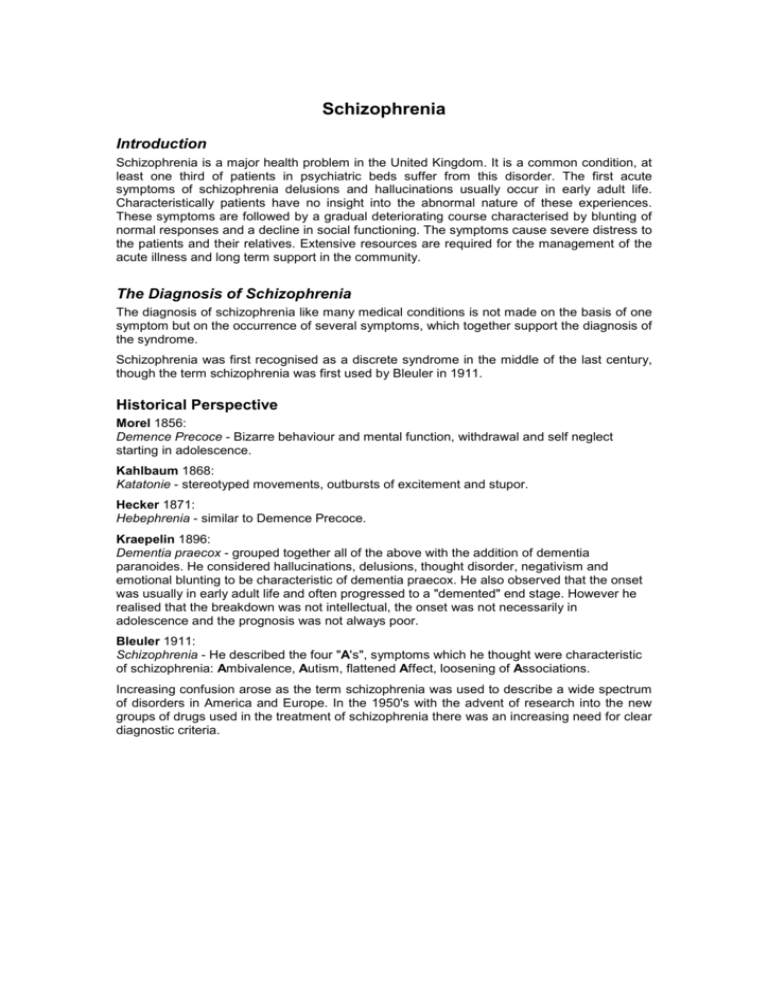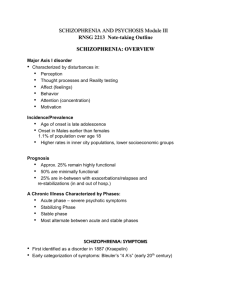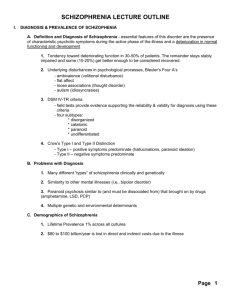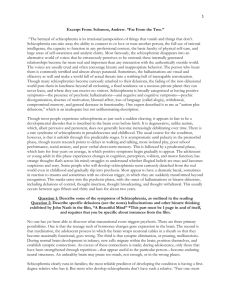Schizophrenia handout
advertisement

Schizophrenia Introduction Schizophrenia is a major health problem in the United Kingdom. It is a common condition, at least one third of patients in psychiatric beds suffer from this disorder. The first acute symptoms of schizophrenia delusions and hallucinations usually occur in early adult life. Characteristically patients have no insight into the abnormal nature of these experiences. These symptoms are followed by a gradual deteriorating course characterised by blunting of normal responses and a decline in social functioning. The symptoms cause severe distress to the patients and their relatives. Extensive resources are required for the management of the acute illness and long term support in the community. The Diagnosis of Schizophrenia The diagnosis of schizophrenia like many medical conditions is not made on the basis of one symptom but on the occurrence of several symptoms, which together support the diagnosis of the syndrome. Schizophrenia was first recognised as a discrete syndrome in the middle of the last century, though the term schizophrenia was first used by Bleuler in 1911. Historical Perspective Morel 1856: Demence Precoce - Bizarre behaviour and mental function, withdrawal and self neglect starting in adolescence. Kahlbaum 1868: Katatonie - stereotyped movements, outbursts of excitement and stupor. Hecker 1871: Hebephrenia - similar to Demence Precoce. Kraepelin 1896: Dementia praecox - grouped together all of the above with the addition of dementia paranoides. He considered hallucinations, delusions, thought disorder, negativism and emotional blunting to be characteristic of dementia praecox. He also observed that the onset was usually in early adult life and often progressed to a "demented" end stage. However he realised that the breakdown was not intellectual, the onset was not necessarily in adolescence and the prognosis was not always poor. Bleuler 1911: Schizophrenia - He described the four "A's", symptoms which he thought were characteristic of schizophrenia: Ambivalence, Autism, flattened Affect, loosening of Associations. Increasing confusion arose as the term schizophrenia was used to describe a wide spectrum of disorders in America and Europe. In the 1950's with the advent of research into the new groups of drugs used in the treatment of schizophrenia there was an increasing need for clear diagnostic criteria. Schneider 1959: First Rank Symptoms - a group of symptoms that Schneider proposed were diagnostic of schizophrenia in the absence of overt brain disease. 1. Auditory hallucinations of a specific type: • Audible thoughts: a voice anticipating or repeating the patients thoughts aloud. • Two or more voices discussing the patient in the third person. • Voices commenting on the patient's behaviour. 2. Thought alienation: • Thought insertion. • Thought withdrawal. • Thought broadcasting. 3. Passivity phenomena: • Experiences of bodily influence. • Made acts/impulses/affects - experiences which are imposed on the individual or influenced by others. 4. Delusional perceptions (A two stage process) where first a normal object is perceived then secondly there is a sudden intense delusional insight into the objects meaning for the patient e.g. "The traffic light is green therefore I am the King". The problem with Schneider's symptoms is that they are: not specific for schizophrenia - 8% of psychotic patients with these symptoms are not schizophrenic for example they may be suffering from delusions or hallucinations in the context of a severely elated or depressed mood state or an organic disorder. not present in some patients with schizophrenia - 20% of chronic schizophrenics do not have them and never had. This is partly explained by the fact that Schneider concentrated on the acute phase of the illness when formulating his first rank symptoms. Schneider's work stimulated the search for optimal diagnostic criteria - one set of criteria used both in clinical work and research are those published in I.C.D.-10 Classification of Mental and Behavioural Disorders. These diagnostic criteria enable a diagnosis of schizophrenia to be made in both acute and chronic phases of the illness. They also reduce the likelihood of the misdiagnosis schizophrenia in those with primary disorders of mood (depression and mania) and organic syndromes such as toxic confusional states and epilepsy. Summary of I.C.D. - 10 Diagnostic Criteria for Schizophrenia The normal requirement for a diagnosis of schizophrenia is that a minimum of one very clear symptom (and usually two or more if less clear-cut) belonging as on of the groups listed a) to d) below, or symptoms of at least two of the groups referred to as e) to h), should have been clearly present for most of the time during a period of 1 month or more. Symptom i) applies only to a diagnosis of simple schizophrenia. a) thought echo, thought insertion, or withdrawal, and thought broadcasting; b) delusions of control, influence, or passivity, clearly referred to body or limb movements or specific thoughts , actions or sensations; delusional perception; c) hallucinatory voices giving a running commentary on the patient's behaviour, or discussing the patient among themselves or other types of hallucinatory voices coming from some part of the body; d) persistent delusions of other kinds that are culturally inappropriate and completely impossible, such as religious or political identity, or superhuman powers and abilities (e.g. being able to control the weather, or being in communication with aliens from another world); e) persistent hallucinations in any modality, when accompanied either by fleeting or half formed delusions without clear affective content, or by persistent over-valued ideas. or when occurring every day for weeks or months on end; f) breaks or interpolations in the train of thought, resulting in incoherence or irrelevant speech, or neologisms; g) catatonic behaviour, such as excitement, posturing or waxy flexibility, negativism, mutism, and stupor; h) "negative" symptoms such as marked apathy, paucity of speech, resulting in social withdrawal and lowering of social performance; it must be clear that these are not due to depression or neuroleptic medication; i) a significant and consistent change in the overall quality of some aspects of personal behaviour, manifested as loss of interest, aimlessness, idleness, a self absorbed attitude, and social withdrawal. Symptoms and Sub-types Prodromal and Residual Symptoms of Schizophrenia Prior to the onset of acute symptoms, (and not due to mood disturbance or substance abuse) and following an acute episode, many patients exhibit less dramatic symptoms. • • • • • • • • • Marked social isolation and withdrawal. Impairment in social role e.g. as a wage earner or student. Peculiar eccentric behaviour. Poor personal hygiene. Blunted or inappropriate affect. Vague speech. Odd beliefs. Unusual perceptual experiences Lack of initiative or energy. Summary of the Symptoms of Schizophrenia The symptoms of schizophrenia can therefore be divided into positive symptoms, seen during acute phases of the illness, and negative symptoms, which are more chronic and responsible for the long term social impairment of patients with chronic schizophrenia. Positive features of schizophrenia: • • • • Hallucinations. Delusions. Ideas of reference. Thought disorder - abnormal patterns of thought reflected in speech. Characterised by the breakdown of normal associations. The associations are often incomprehensible to the listener. Negative features of schizophrenia: • • • • Social withdrawal. Emotional blunting. Underactivity. Lack of motivation. Subtypes of Schizophrenia Four subtypes of schizophrenia have been described where particular clinical patterns have been observed. Simple Schizophrenia. Negative symptoms predominate. Hebephrenic schizophrenia. Mood is inappropriate with giggling and shallowness, behaviour is irresponsible. Delusions and hallucinations are fragmented. Thoughts are disorganised. Onset typically age 15-25. Paranoid schizophrenia. Complex delusions and hallucinations. Delusions may be persecutory, grandiose or religious. Catatonic schizophrenia. Psychomotor disturbance varying from stupor to sudden outbursts of activity. Waxy flexibility, automatic obedience and negativism. Schizoaffective disorder This diagnosis should be limited to cases where diagnostic criteria for both schizophrenia and a mood disorder occur during the same episode. Otherwise the diagnosis is of the predominant syndrome. Epidemiology Schizophrenia is a common disorder requiring extensive health care provision. Incidence • • • • point prevalence is 0.5% lifetime risk of developing schizophrenia is 1% there is equal incidence in both sexes it often manifests in the second and third decade people but can occur at any age Social class Increased rates are found in deprived socially isolated areas of large cities. This may be due to social drift i.e. the sufferer drifts to these areas as a result of their illness (e.g. cardboard city). Comparison of the socio-economic classes of the fathers of schizophrenics reveals no increased incidence in any particular class. Genetics When the risk for an individual related to a patient with schizophrenia is explored the prevalence is dependent on their relationship to sufferer. So that the risk for each subset of relatives is: • • • • Parent - 5% Child of one schizophrenic parent - 12% Child of two schizophrenic parents - 46% Sibling - 8% In twin studies the concordance rates were: • • Dizygotic twins 9% Monozygotic twins 42% Aetiology Dopamine hypothesis Abnormalities in the dopamine pathways have been implicated as: • • • • Amphetamines, LSD, bromocriptine and L-dopa can cause schizophrenic like symptoms and are known to enhance dopamine. Many (‘typical’) anti-schizophrenic drugs are dopamine antagonists and can cause Parkinsonian like symptoms. Drugs with geometric isomers are only effective when the isomer is anti-dopaminergic. Some limbic pathways that are thought to control mood, behaviour and thought processing utilise dopamine as a neurotransmitter (e.g. mesolimbic, mesocortical). Neurological dysfunction Symptoms similar to schizophrenia are seen in complex partial seizures where left temporal lobe limbic structures are involved e.g. temporal lobe epilepsy. Birth complications are associated with an increased risk of schizophrenia suggesting that neurological insults at an early age may play a role in the development of schizophrenia in some individuals. The increased rates of winter or spring births (around 10%) found in sufferers may be associated with an increased risk of schizophrenia. The cause, is as yet, unclear but third trimester maternal infection with viruses such as influenza or polio has been postulated. Scanning studies in schizophrenics have found smaller structures in the left temporal lobe, ventricular enlargement (correlated with the severity of negative symptoms) and hypofrontality (with functional imaging). Movement disorders occur in even unmedicated schizophrenics. Genetic The risk for individuals with an affected relative has already been discussed in the section on epidemiology. In addition, since the concordance in twins and other relatives living with a schizophrenic could be attributed to "psychosocial" factors, adoption studies have been carried out. In one study by Heston et al 5 out of 47 children of schizophrenic mothers who were adopted out at birth developed schizophrenia, as opposed to 0 out of 50 controls. In addition around 20% of biological relatives suffered from some form of the disorder, compared to only 6% of adoptive relatives. (These figures became 13% and 1.6% respectively when DSM-III criteria were used). Prognosis Because of case-to-case variability, prognosis cannot be confidently predicted for an individual case, but studies of large patient groups revealed the following prognostic indicators. Good prognosis associated with: • • • • Sudden onset Precipitants Family history of affective illness Good premorbid adjustment Poor prognosis associated with: • • • • • • • • Early onset and/or insidious onset Lack of precipitants Lack of affective components Abnormal pre-morbid personality Family history Exposure high expressed emotion in the patient’s family Low IQ Negative symptoms With treatment the average outcome rates are: • • • • 25% good recovery 50% chronic fluctuating course 15% continuous symptoms requiring long-term care 10% severe incapacity Management of schizophrenia As with all patients suffering from a mental illness, management should be divided into assessment and treatment. At both stages psychological, physical, social factors should be considered. Assessment The initial assessment during the acute illness often takes place in hospital but may be carried out on an out-patient or day-patient basis by various members of hospital and community mental health team staff. This assessment should include: • • • • • Full history and mental state examination in particular identify delusions, hallucinations, thought disorder. Check for clouding of consciousness. Interview with an informant. Physical examination and appropriate investigations e.g. urine drug screen to exclude a drug induced psychosis, EEG to exclude temporal lobe epilepsy, brain imaging. Social assessment; housing, work, etc. By the end of the assessment: • • • • • • • Information supporting the diagnosis should have been collected. Particular risks the patient may present to themselves and others should have been identified. Vulnerability factors such as a family history of schizophrenia should have been considered. Possible precipitants to the acute illness should have been identified (why now ?). Factors which may maintain the illness or make relapse more likely should be explored such as high critical expressed emotion within the family or stresses at work. Decide whether the patient is prepared to accept treatment. Consider a differential or coexisting disorder such as: a) b) c) d) Drug induced psychosis, amphetamines, LSD. Alcoholic hallucinosis. Organic causes, acute confusional state, DT's, temporal lobe epilepsy. Affective psychosis, depression, hypomania. Treatment Physical The mainstay of treatment is pharmacotherapy. A group of drugs called the neuroleptics also known as major tranquillisers are used. The drugs that have been in longest use (the ‘typical’ antipsychotics/neuroleptics) block dopamine receptors and are classified according to their chemical structure. More recently a number of drugs have been introduced that act mostly on transmitter systems other than dopamine and are therefore termed ‘atypical antipsychotics/ neuroleptics’. Depot preparations administered every 2-4 weeks allow monitoring of patient compliance. They are usually given by a community psychiatric nurse, which also has the advantage of close monitoring of the patient's mental state and anticipation and prevention of relapse. Further discussion of this group of drugs is given in the pharmacotherapy handout. Psychological Treatments These are aimed at support and reduction of stress. Family work with education about the illness may be particularly important when the family is hostile and critical towards the patient e.g. having unrealistic expectations of them. High critical expressed emotion is associated with an increased risk of relapse, particularly when the sufferer spends long periods at home with their family. Social Rehabilitation Rehabilitation into work where relevant or attendance at a day centre. Balance between too much stress and under-stimulation with social withdrawal and apathy. Where return home is not possible (e.g. rejected by the family and/or independent living not possible) alternative accommodation may be sought in a hostel, group home or supportive lodging.







